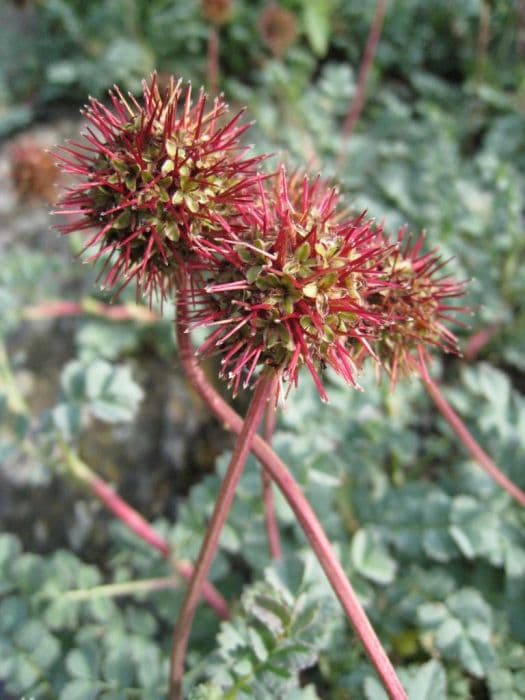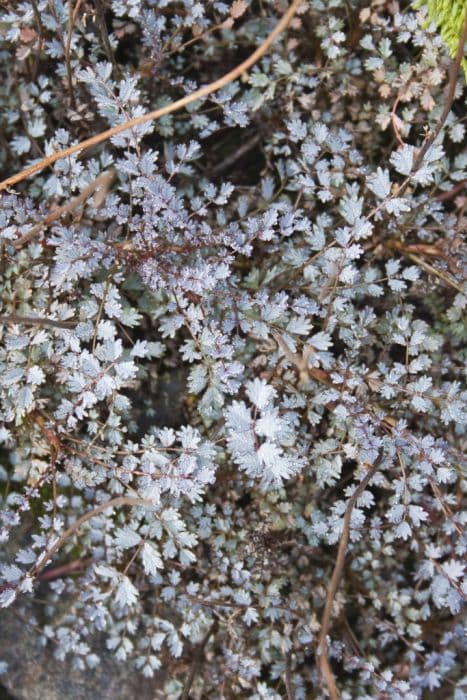Apple Blossom Rose Rosa Apple Blossom = 'Noamel' (GC)
![rose [Apple Blossom]](/_next/image?url=https%3A%2F%2Fplants-admin.emdemapps.com%2Fimages%2Fplants%2F%2Fimages%2F604b61f689efe.png&w=3840&q=75)
ABOUT
Rosa 'Apple Blossom' is a flowering plant popular for its stunning blooms. This variety is known for its light pink flowers that resemble the delicate features of apple blossoms, thus the name. The plant exhibits clusters of flowers that create a soft, picturesque display. The petals have a soft, almost translucent quality to them with a subtle gradation of pink hues that are more concentrated at the center and fade towards the edges. The flowers are typically full and rounded, with multiple layers of petals that unfurl as they bloom. The leaves of Rosa 'Apple Blossom' are typically a rich green color, providing a lush background for the delicate pink flowers. The leaves have a glossy finish, with a slightly leathery texture, which contrasts nicely with the soft, romantic appearance of the flowers. The overall appearance of the plant is one that exudes grace and charm, making it a favored choice for gardens and decorative arrangements. This rose variety brings an air of traditional elegance and natural beauty to any setting in which it's planted.
About this plant
 Names
NamesSynonyms
Apple Blossom Rose, Noamel Rose.
Common names
Rosa 'Noamel'
 Toxicity
ToxicityTo humans
The Rosa 'Noamel', commonly known as the Floribunda or Cluster-flowered rose, is not considered highly toxic to humans. Ingesting parts of this plant is generally not known to cause serious harm. However, some individuals may experience mild stomach upset if they consume parts of it. The main concern with roses is typically the physical injury from the thorns rather than toxicity from ingestion.
To pets
The Rosa 'Noamel', commonly referred to as the Floribunda or Cluster-flowered rose, is generally considered non-toxic to pets such as dogs and cats. Ingesting the plant may result in mild gastrointestinal upset, but it does not typically lead to severe poisoning. As with humans, the thorns on the rose may pose a risk of physical injury to pets.
 Characteristics
CharacteristicsLife cycle
Perennials
Foliage type
Deciduous
Color of leaves
Green
Flower color
Pink
Height
4-5 feet (1.2-1.5 meters)
Spread
3-4 feet (0.9-1.2 meters)
Plant type
Shrub
Hardiness zones
6
Native area
Asia
Benefits
 General Benefits
General Benefits- Ornamental Appeal: Offers an aesthetic addition to gardens with its delicate apple blossom-like flowers.
- Landscape Versatility: Suitable for various landscape purposes including borders, hedges, and as a specimen plant.
- Attracts Pollinators: Invites bees, butterflies, and birds, supporting local ecosystems.
- Fragrance: Provides a pleasant fragrance which can enhance the sensory experience of a garden or landscape.
- Seasonal Interest: Offers a seasonal display of blooms typically in spring, adding to the visual interest of the area.
- Hardiness: Generally robust and resilient to a variety of growing conditions once established.
- Longevity: Can live for many years, providing a long-term presence in the landscape.
 Medical Properties
Medical PropertiesThis plant is not used for medical purposes.
 Air-purifying Qualities
Air-purifying QualitiesThis plant is not specifically known for air purifying qualities.
 Other Uses
Other Uses- Rosa Apple Blossom petals can be used as a natural dye for fabrics or paper, providing a subtle pink hue when processed correctly.
- The strong and pleasant scent of Rosa Apple Blossom makes it suitable for homemade potpourri, providing a natural fragrance in homes.
- The essential oils extracted from the Rosa Apple Blossom can be used in aromatherapy to create relaxing or romantic atmospheres.
- Petals of the Rosa Apple Blossom can be infused in vinegars, adding a floral note to culinary creations and salad dressings.
- The plant can serve as an educational tool in schools to teach students about botany, plant reproduction, and the importance of pollinators.
- Dried Rosa Apple Blossom petals can be utilized in crafting, such as in making natural candles or embedded in homemade soaps.
- Flowers of the Rosa Apple Blossom can be used as a natural confetti at celebrations, offering an eco-friendly alternative to synthetic versions.
- The plant can be integrated into landscape designs as a living fence or barrier, providing both aesthetic appeal and privacy.
- Rosa Apple Blossom's strong growth habit can help stabilize soil and prevent erosion in certain garden areas.
- The branches and thorns of the Rosa Apple Blossom can be used to create organic, textured art pieces or rustic home decor items.
Interesting Facts
 Feng Shui
Feng ShuiThe Apple Blossom is not used in Feng Shui practice.
 Zodiac Sign Compitability
Zodiac Sign CompitabilityThe Apple Blossom is not used in astrology practice.
 Plant Symbolism
Plant Symbolism- Love and Affection: As a member of the rose family, the Rosa 'Apple Blossom' traditionally symbolizes love and affection, representing deep emotions and connections between individuals.
- Beauty and Femininity: The delicate blossoms of the Rosa 'Apple Blossom' are often associated with beauty and femininity, reminding us of the soft and subtle grace possessed by both the flower and womanhood.
- New Beginnings: The emergence of blossoms from the Rosa 'Apple Blossom' signifies new beginnings and the awakening of nature, making it an emblem of renewal and fresh starts.
- Grace and Elegance: The gentle appearance of the Apple Blossom rose lends itself to symbolize grace and elegance, highlighting the natural poise that the flower exudes.
- Hope and Optimism: Associated with springtime and rebirth, the Rosa 'Apple Blossom' imparts a sense of hope and optimism, mirroring the optimism of life and the anticipation for what lies ahead.
 Water
WaterThe Apple Blossom Rose should be watered thoroughly, ensuring the soil is moist but not waterlogged. During the growing season, watering should occur once or twice a week, depending on the weather conditions and the soil's moisture level. Each watering session should provide enough water to penetrate the soil deeply, about 1 to 2 inches. It is better to water less frequently but deeply rather than little and often to encourage deep root growth. In hotter months or drier climates, the water requirement may increase to 2 gallons per week, while in cooler or rainy conditions, watering should be reduced as necessary to prevent overwatering and potential root rot.
 Light
LightThe Apple Blossom Rose requires full sun to thrive, which means it should receive at least six hours of direct sunlight each day. A spot that provides morning sun and some light afternoon shade could be ideal to protect the plant from the intense afternoon heat in very hot climates. However, too much shade can lead to fewer blooms and a weakened plant.
 Temperature
TemperatureThe Apple Blossom Rose can tolerate a range of temperatures, but it performs best in conditions where the average temperature is between 65 to 75 degrees Fahrenheit. While it can survive minimum temperatures down to around 20 degrees Fahrenheit, it is important to protect the plant from freezing conditions which can cause damage. The ideal growing temperature does not exceed 85 degrees Fahrenheit during the day as excessive heat may stress the plant.
 Pruning
PruningPruning the Apple Blossom Rose is essential for maintaining plant health, encouraging new growth, and promoting abundant flowering. Prune in late winter or early spring, before new growth starts, removing dead and diseased wood and thinning out crowded areas to improve air circulation. It's recommended to prune once a year, cutting back about one-third of the plant to shape it and spur the development of strong, new canes.
 Cleaning
CleaningAs needed
 Soil
SoilClimbing Rose 'Apple Blossom' thrives in well-draining soil rich in organic matter with a pH between 6.0 and 6.5. A mix of two-thirds garden soil and one-third compost or well-rotted manure is ideal.
 Repotting
RepottingClimbing Rose 'Apple Blossom' typically doesn't need frequent repotting if planted in the ground but can benefit from rejuvenation of the surrounding soil every 2 to 3 years.
 Humidity & Misting
Humidity & MistingClimbing Rose 'Apple Blossom' prefers average outdoor humidity levels, typically between 40% and 60%, avoiding overly humid conditions to prevent disease.
 Suitable locations
Suitable locationsIndoor
Ensure a sunny spot and good air circulation for indoor Climbing Rose 'Apple Blossom.'
Outdoor
Plant in full sun, amend soil with compost, and ensure proper spacing for Climbing Rose 'Apple Blossom.'
Hardiness zone
5-9 USDA
 Life cycle
Life cycleThe Rosa 'Apple Blossom' (Garden Carpet) begins its life cycle with seed germination, occurring in optimal light and temperature conditions. Following germination, the seedling stage is characterized by the development of a basic root system and the initial set of leaves. As it enters the vegetative stage, the plant develops a stronger root structure, more leaves, and stems; in this period, it focuses on accumulating resources and growth. Transitioning to the reproductive stage, the plant starts to develop flower buds, which, when matured, open into the distinctive apple blossom flowers that are white to soft pink. After pollination, typically involving insects like bees, the flowers will develop into fruits containing seeds, completing the reproductive cycle. Once mature, these seeds can drop to the ground or be dispersed to propagate the next generation of Apple Blossom roses, starting the cycle anew.
 Propogation
PropogationPropogation time
Spring-Early Summer
Propogation: Rosa 'Apple Blossom', commonly known as the 'Noamel' garden rose, is often propagated through the method of softwood cuttings. This is usually done in late spring to early summer, when the rose stems are green and flexible. Gardeners select healthy, non-flowering shoots from the current year's growth and cut a piece around 6 inches (approximately 15 cm) long. The lower leaves are removed, and the cut end may be dipped in rooting hormone to encourage root growth. The cutting is then planted in a well-draining soil mix, ensuring that several nodes where leaves were removed are below the soil surface. The environment should be kept humid, often through the use of a plastic cover, and the cutting should be placed in indirect light until roots develop, generally taking several weeks to a few months depending on conditions.









